Ever since GM downsized itself out of contention, Volkswagen and Toyota have closely contested the title of "world's largest auto maker." In 2019, VW attained the top spot, but last year bragging rights went to Toyota. The deciding factor: the German company's U.S. market share remains just one-fifth its share in the rest of the world. VW would like to double its share here, and its strategy for achieving this might seem simple: "give consumers what they clearly are looking for." But this is...what?
After all, VW thought it knew what Americans wanted when it launched a serious push for U.S. market share a decade ago. Compared to the Jetta and Passat sold in Europe, the new ones tailored for Americans were larger and cheaper. A new plant was built in Chattanooga to assemble the Passat. The new cars sold well at first, doubling VW's market share, but then lost steam. While VW had opted to develop two new sedans, consumer preferences were rapidly shifting to crossovers.
So, for 2018 Volkswagen introduced a redesigned Tiguan compact crossover and an all-new Atlas large crossover. While the Tiguan is offered in two lengths in many markets, the U.S. gets only the long wheelbase variant. VW applied its "bigger and cheaper for Americans" strategy even more thoroughly with the designed-for-America, made-in-Tennessee Atlas. The new crossover landed more American buyers in its first two model years than its smaller-yet-pricier predecessor had in 14. Despite its value pricing (by German standards), each Atlas earned more profit than eight Passat sedans.
Alas, two crossover models can only do so much when competitors offer four to six. VW has added a sporty variant of the Atlas and the ID.4 EV. But for big gains, it needs to fill the space left vacant when the Tiguan grew, and is doing this with the new-for-2022 Taos. So, is the new Taos what consumers are looking for?
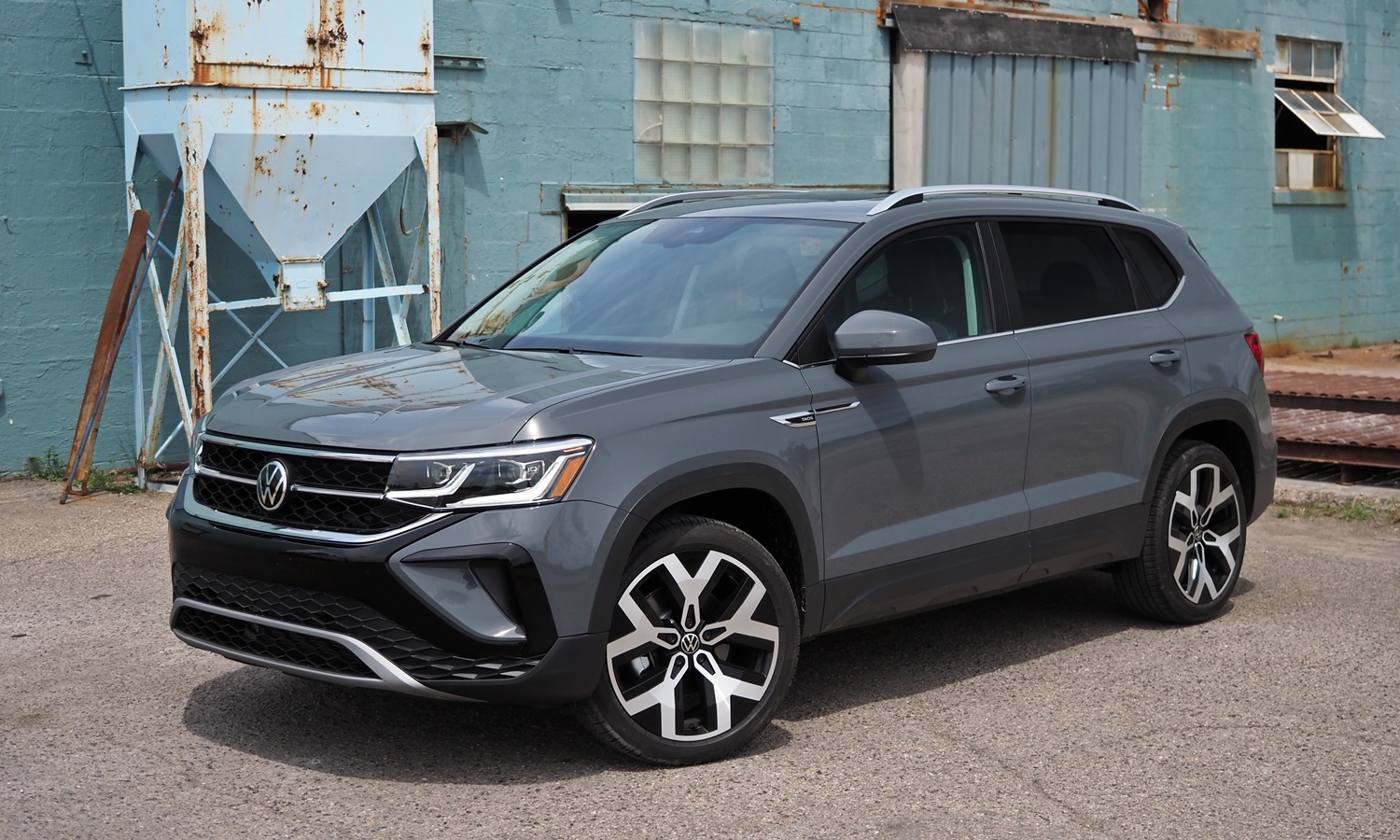
As with the larger Atlas, there's a look of Jeep Grand Cherokee here. more Taos photos
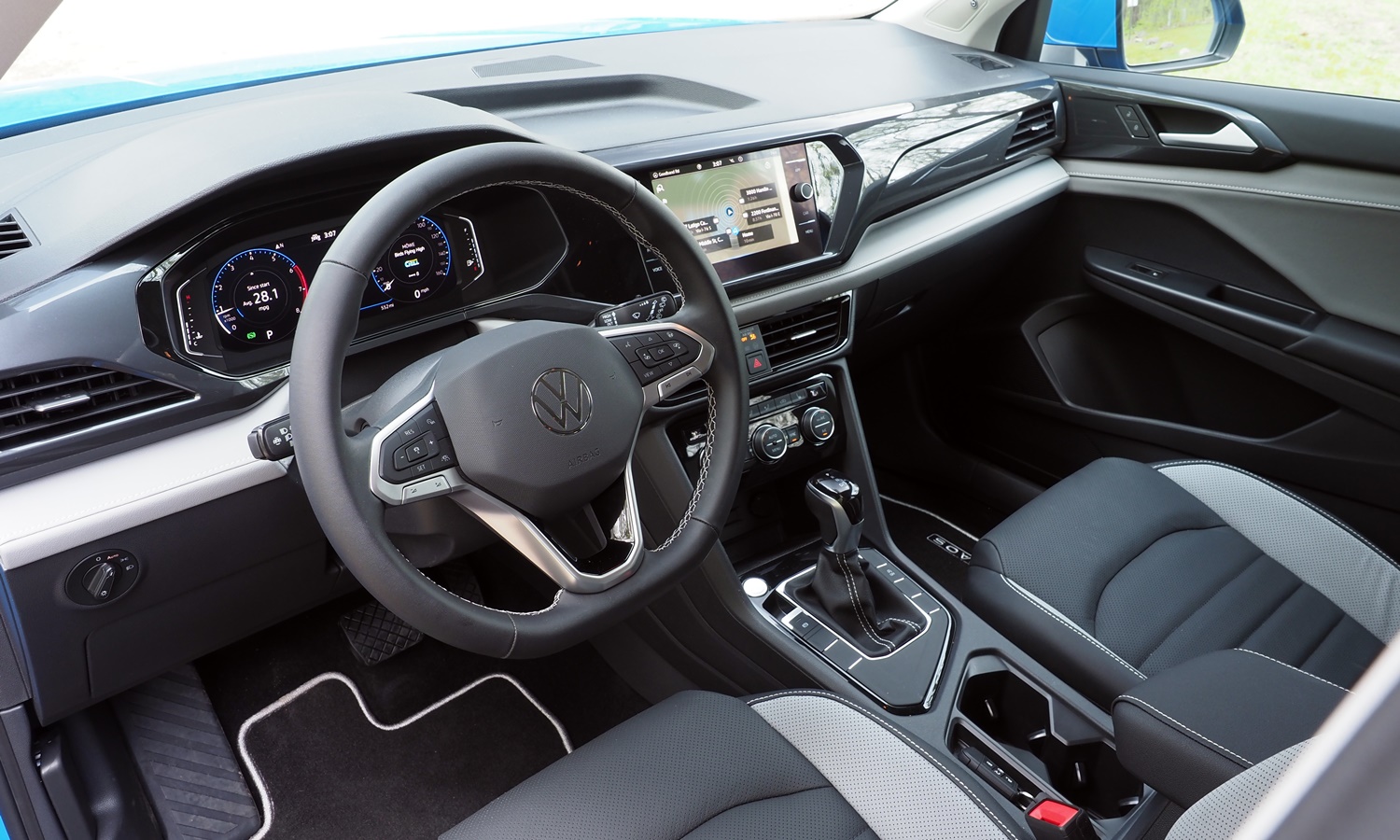
Clean, simple forms and conventional controls--we're clearly entering a VW.
| |
Compared to the Seltos |
| Rear seat room & comfort |
 Better
Worse
Better
Worse
|
Volkswagen's "bigger for Americans" strategy continues with the Taos. Even though the new crossover is the smallest VW offers in North America, its rear passengers enjoy a seat set comfortably high off the floor and plenty of room for their heads, shoulders, and legs. On their spec sheets the Kia Seltos and Chevrolet TrailBlazer offer more combined legroom, but I observed more space in the VW. The top two trim levels include rear air vents.
Why, then, would someone spend a few thousand more for the Tiguan? Perhaps they occasionally need a third-row seat but don't want a crossover the size of the Atlas. The Tiguan's second-row seat isn't quite as roomy as the Taos's, but unlike the latter it can slide and recline.
| Cargo capacity |
 Better
Worse
Better
Worse
|
Compared to the Seltos, TrailBlazer, et al., the Volkswagen Taos can also hold more cargo: 28 cubic feet with the rear seat up and 66 with it folded. Even the next-best Kia Seltos falls a few cubes short. Most competitors fall far short (45 cubic feet in the Mazda CX-30, 55 cubic feet in the Chevrolet TrailBlazer and Subaru Crosstrek). When fitted with a third-row seat, standard with front-wheel-drive, the Tiguan only ties the Taos.
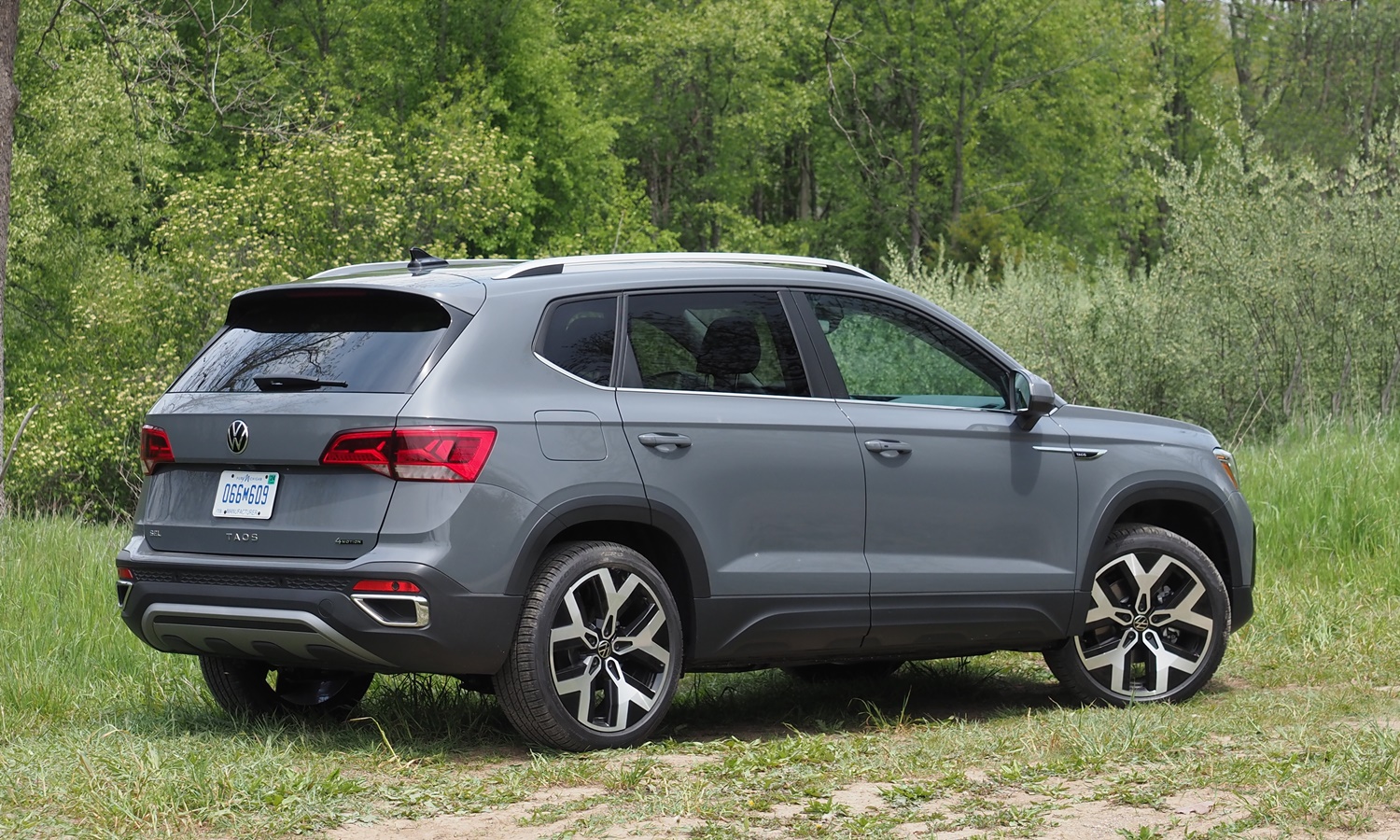
The top of the front fender flows cleanly into the tops of the doors.
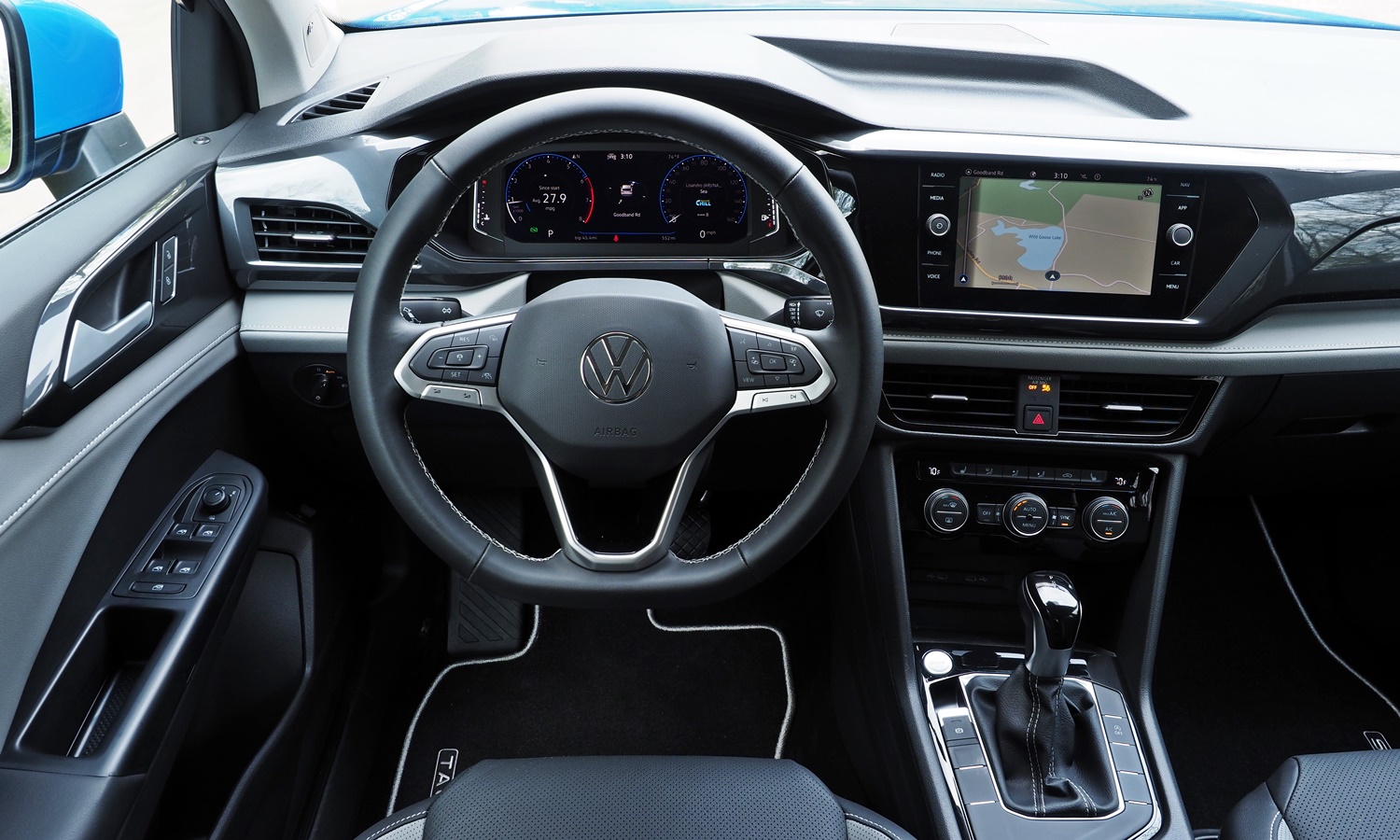
Many people will like that the display doesn't stick up. Plenty of conventional knobs.
| Feature availability |
 Better
Worse
Better
Worse
|
VW is also betting that Americans want scads of convenience, luxury, and safety features in their roomy vehicles. While even the typical small crossover offers far more features than compact cars used to, the Taos offers the most. Premium features include leather upholstery (though it feels synthetic), a heated steering wheel, heated-and-ventilated front seats, dual-zone automatic climate control, a large reconfigurable LCD instrument cluster, all-LED exterior lighting with auto-dimming and steering-linked headlights, configurable interior ambient lighting, full-speed-range adaptive cruise control, and lane-keep assist. One or two competitors offer a feature or two the VW does not, most notably a power liftgate or memory for the driver seat, but they don't offer other features that the Taos does.
| Fuel economy |
 Better
Worse
Better
Worse
|
With front-wheel-drive and an eight-speed automatic transmission, the VW Taos achieved 27 mpg in the EPA's city test and 36 mpg in its highway test. The latter is best-in-class, while the former is just a couple mpg short of the best. This fuel economy helps blunt the historical criticism of SUVs: that they use far more gas than sedans or wagons. The Jetta sedan manages just two mpg better in the city and three mpg better on the highway with a smaller, less powerful engine.
Adding all-wheel-drive and its attendant seven-speed DCT reduces the EPA ratings to 25/32. Compared to other compact crossovers these figures are at least competitive. The Seltos SX with AWD is rated 25/30, the TrailBlazer with 4WD, 26/30. While I wasn't able to evaluate the Taos's real-world fuel economy during the few hours I drove it, past experience with VWs suggests that, when driven conscientously, they easily exceed their EPA ratings. Turbocharged engines tuned for a broad, flat torque curve help--there's little need to rev them in typical daily driving.
| Controls and instruments |
 Better
Worse
Better
Worse
|
Given how creative some automakers have been getting with interfaces, it's refreshing to find two knobs for the audio system and three knobs for the HVAC in the VW Taos. The driving mode button in the AWD Taos also proved easy to find in an instant without taking my eyes off the road.
Unlike on the Kia Seltos and many competitors, the infotainment display on the Taos does not stick up above the instrument panel. Consequently, it requires that the driver look more away from the road or that the instrument panel be higher; probably a bit of both. It also forces the HVAC vents lower. But, as VW likely discovered in its consumer research, many people will prefer the resulting appearance.
| |
Compared to the Seltos |
| Price or payments |
 Better
Worse
Better
Worse
|
Recall the second bit of Volkswagen's American strategy: lower prices. Not lower than those of the Koreans, but lower than those of its European products. The Taos is based on a model initially developed for the Chinese market. Like the Atlas but unlike the Tiguan, the Taos is not offered in Germany. Like the North American Tiguan, it will be assembled in Mexico. We have a clear recipe for a low price and/or high profits. But which?
VW says the Taos will be priced $2,500 to $3,000 below the updated-for-2022 Tiguan, but the price of the latter is going up now that the Taos has arrived to contest the low ground. Compared to the 2021 Seltos, the 2022 Taos starts about $1,000 higher ($24,190 vs. $23,110) despite the S-trim Kia having about $1,000 in additional standard features. (The Seltos LX, with fewer features, is only offered with AWD.) Load both up, and the Taos tops out $5,730 higher ($35,440 vs. $29,710). About $1,400 of this difference can be attributed to additionial content. But this leaves an adjusted difference of about $4,400--not pocket change. Even when designed for China and assembled in Mexico, a German-engineered vehicle costs more.
Leasing might help. The Taos is predicted to retain its value well; the forecast residual value enables a $199 per month lease.
| Materials & workmanship |
 Better
Worse
Better
Worse
|
The interior materials of the Taos aren't below the class average, but aside from the SEL's LCD instrumentation these don't look or feel better than the class average, either. The leather feels like vinyl, and hard plastic tops the instrument panel.
If you want a VW crossover with interior materials like those in the GTI, well, you can't buy it in the U.S. Volkswagen learned the hard way that too few Americans are willing to pay for its European-grade products. In its best year--by far--the Touareg found 27,706 American buyers. From 2007 on it only cracked 10,000 per year once, and twice bottomed out around 4,000. Per year. Recently VW has been selling over 30,000 Atlases per quarter. Case closed.
The above said, the Tao's interior materials are significantly better than those in VW's earlier efforts at American-market cars, the 2011 Jetta and 2012 Passat. They might even be a bit better than those in the Kia Seltos. I'd need to drive them closer together to be sure.
This isn't a major complaint. I don't have any major complaints about the Taos (unless it proves as troublesome as the Atlas was its first couple of years). VW has successfully designed a vehicle without evident deal-killers.
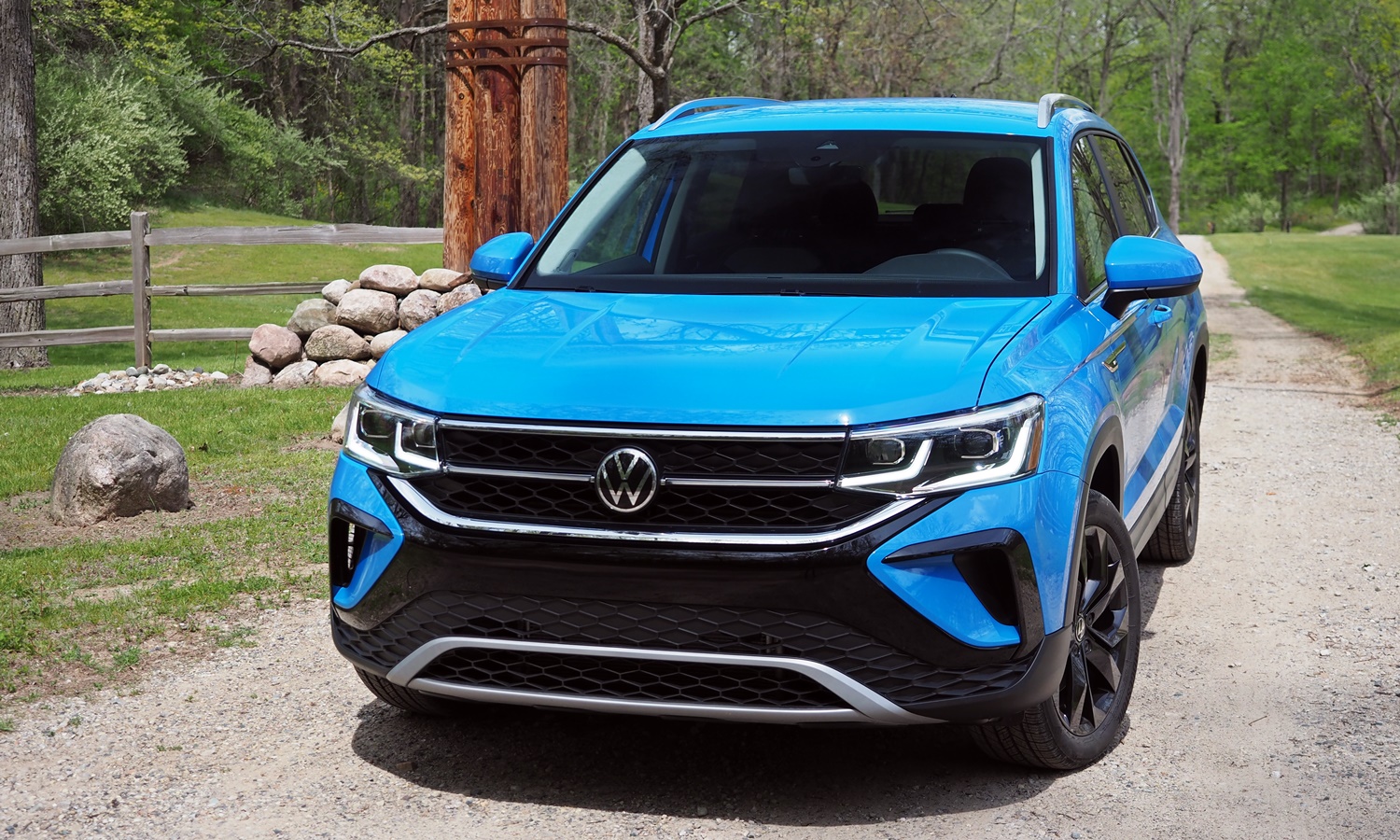
SEL has fancier headlights than lesser trims. All have a more aggressive face than the Tiguan.
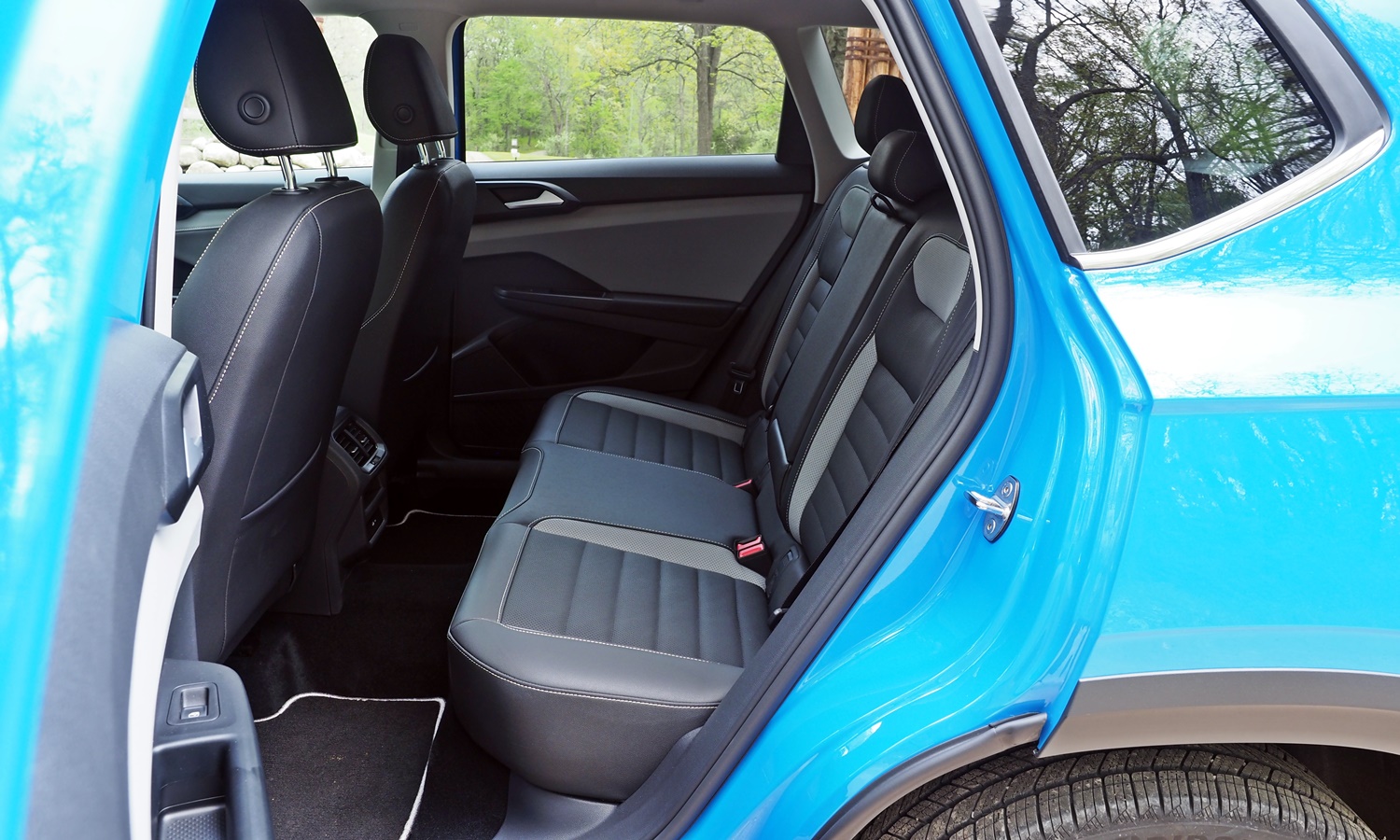
Plenty of room in the high-mounted rear seat.
| |
Compared to the Seltos |
| Exterior styling |
 Better
Worse
Better
Worse
|
The cynic in me suspects that we're getting the Taos rather than the short wheelbase Tiguan (the two are very close in size) because the former, initially engineered for the Chinese market, is significantly less expensive to make. But nothing aside from the front-wheel-drive Taos's beam rear axle is obviously cheaper than what you'll find in the Tiguan (if memory serves; I last drove a Tiguan in October 2017).
So maybe the official explanation is the real one: VW offers us the Taos rather than the short wheelbase Tiguan because the former differs more than the latter from the Tiguan we do get, and thus is more likely to appeal to a different market.
Most obviously, while the Tiguan has car-like round wheel openings, the Taos--like the Atlas that was designed primarily for the U.S. market--has squarer, truckier ones. Its rugged forms wouldn't look out of place in the Jeep line-up. Handsome in the right colors--the gray works well, the bright blue with black wheels not so much--but not striking. I personally find the Kia Seltos a more artful execution of a similar theme. But the Taos does make a stronger design statement than the Tiguan.
Inside, the Taos is typical VW, with clean, simple forms and nothing trendy. Even the reconfigurable LCD display replicates round analog gauges.
| Powertrain performance |
 Better
Worse
Better
Worse
|
If it wanted to, Volkswagen could drop the performance-oriented GTI hatchback's powertrains into the Taos. Apparently it doesn't want to. The Taos is offered with a single engine, a 158-horsepower turbocharged 1.5-liter four-cylinder. This engine has enough torque (184 lb-ft @ 1,750 rpm) to not feel sluggish. But if you're seeking excitement, you're not going to find it here any more than you will in the 184-hp Tiguan.
The 175-horsepower turbocharged 1.6-liter engine in the Seltos feels considerably stronger--but it's only offered in the top-of-the-line SX. The Taos's engine has an edge over the 146-horsepower 2.0-liter in the lesser Seltos. And over the turbo 1.3 in the Chevrolet TrailBlazer. With one exception, the VW 1.5T engine struck me as thoroughly adequate.
The exception: once when turning onto a busy highway I wanted to get up to speed pronto. I floored the throttle from a dead stop, and for what seemed like many, many seconds (more likely somewhere between one and two) very little happened. Once you're moving turbo lag seems minimal; from a dead stop, different story.
Two transmissions are paired with the 1.5T engine. With front-wheel-drive you get an eight-speed conventional automatic. With AWD you get a seven-speed dual-clutch automated manual transmission (DCT or, in VW parlance, DSG). The DCT responds somewhat more quickly and shifts more crisply than the automatic, especially in sport mode. Either trans behaves far better than the Kia's DCT, which feels downright odd in casual driving below 20 mph.
I tripped across one programming quirk--neither transmission would accept a manual downshift (via the lever, there are no paddles) that would put the engine over 4,000 rpm. Perhaps the engineers reasoned that, given the 1.5T's torque curve, there's no need to venture over 4,000 rpm. But toggle the transmission into sport mode and, when it senses a need, it'll downshift itself into a gear that sends the engine over 4,000 rpm. How it knows when and when not to do this I don't know, but it does.
With many vehicles I avoid leaving the powertrain in sport mode because the transmission then holds an overly low gear when just cruising along at a steady speed. The transmissions in the Taos do not do this. When just cruising along they seemed to select the same gear in either mode. But start driving more aggressively and both promptly switched to more aggressive programming.
The upshot: on twisty roads I selected sport mode and let the transmission handle all the shifting. Both did so well (the DCT a bit better than the conventional automatic) that I didn't bother with shifting them manually.
Compared to the powertrain in the Seltos, the VW's engine is weaker but its transmission is much better programmed. The Kia can be more fun, but it can also be more annoying. Which is better overall? It depends on the situation. I've marked them even.
| Handling |
 Better
Worse
Better
Worse
|
The VW Taos is similarly no GTI in the chassis department. Two different rear suspensions are offered. The FWD Taos has a rear beam axle with no stabilizer bar, while the AWD Taos has a multi-link rear suspension with a stabilizer bar. The FWD Taos felt lighter and more agile, but less taut. This might be because it is 255 pounds lighter and its spring rates are lower.
The FWD Taos also seemed less prone to evident understeer when diving into fairly tight curves. This surprised me given its lack of a rear stabilizer bar. The weight difference? Rear suspension geometry? Different tires (18-inch Bridgestone LS100s vs. 19-inch Pirelli Scorpion Zeros)? Maybe I drove the AWD Taos more aggressively? Just all in my head? I can't say for sure--just conveying my impressions.
With either suspension, but especially with the FWD crossover's, the Taos felt a little loose and even floaty in transitions. Once it took a set the VW felt stable and predictable, but in the trasition from a left-handed curve to a right-hander (or vice-versa) it was very clearly no tautly suspended GTI.
The Taos's steering contributed to this less-than-sporty character. In the default mode--which is the only mode with FWD--this steering feels quite light and has some slack on-center. AWD includes a button-selectable sport mode that goes beyond the transmission's lever-selectable sport mode to also firm up the steering to a moderate but noticeable extent. In either mode the steering has the thoroughly (overly?) damped, somewhat artificial feel I've noticed in other recent VWs. The steering in the Kia Seltos provides more feedback (if still not much).
I'll also note that, for better or for worse (depending on your tastes) the Taos does not drive like a light, compact vehicle. The Kia Seltos isn't any lighter, but it feels lighter and more agile, perhaps because it is 1.6 inches narrower.
To sum up this section, the Taos feels thoroughly stable and predictable, even somewhat subtantial (though not the archetypal German vault-on-wheels), but rarely if ever sporty.
| Front seat support & comfort |
 Better
Worse
Better
Worse
|
The VW Taos's front seats are shaped much to my taste, and provide better lateral support than most compact crossover buyers will ever need. VW could sportify the suspension without having to also upgrade the seats.
The windshield is raked at a moderate angle so the instrument panel isn't overly deep. The view forward would be more open if the instrument panel and cowl were lower, but this might detract from the rugged SUV character most buyers seem to want.
| Ride smoothness |
 Better
Worse
Better
Worse
|
The AWD Taos rides somewhat more firmly than the FWD Taos, with occasional head-toss on bumpy roads, but either rides more smoothly than the Kia Seltos.
I wasn't able to drive the VW Taos back-to-back with any other crossover. That said, the Taos seemed quieter inside than the class average. When I drove the Tiguan and Atlas a few years ago I noted various lapses in refinement. In contrast, the Taos has few rough edges.
For me, there's not enough in the Taos's aesthetic or dynamic character to distinguish this VW from its less expensive Asian and American competition in the increasingly crowded compact crossover class. Very likely this similarity of character follows from a similarity of objective: to tune these crossovers to suit the tastes of the typical American buyer.
Then why buy the VW? Perhaps the Germans (with assistance from their California design center), working from a vehicle initially designed for China, have managed to satisfy the needs and wants of the middle-of-the-road American buyer better than competitors aiming at the same target. The Taos likely has the right look and the right feel for the typical compact crossover buyer. It's somewhat roomier than competitors, drives nicely, and gets best-in-class fuel economy on the highway.
After all, Mazda has set itself apart from the pack, only to lag well behind the leaders in sales. Offering the GTI of crossovers wouldn't get VW its desired five-percent share of the American market. Offering a more compact rendition of the Atlas might (as long as Tiguan sales aren't cannibalized too much).
If Taos sales do fall a bit short, VW can always pop in some GTI bits to try to make up the shortfall. The two options aren't mutually exclusive. Actually, VW has signalled that they will be offering another Taos variant, but much more off-road than canyon-road. That's what crossover consumers seem to be looking for.
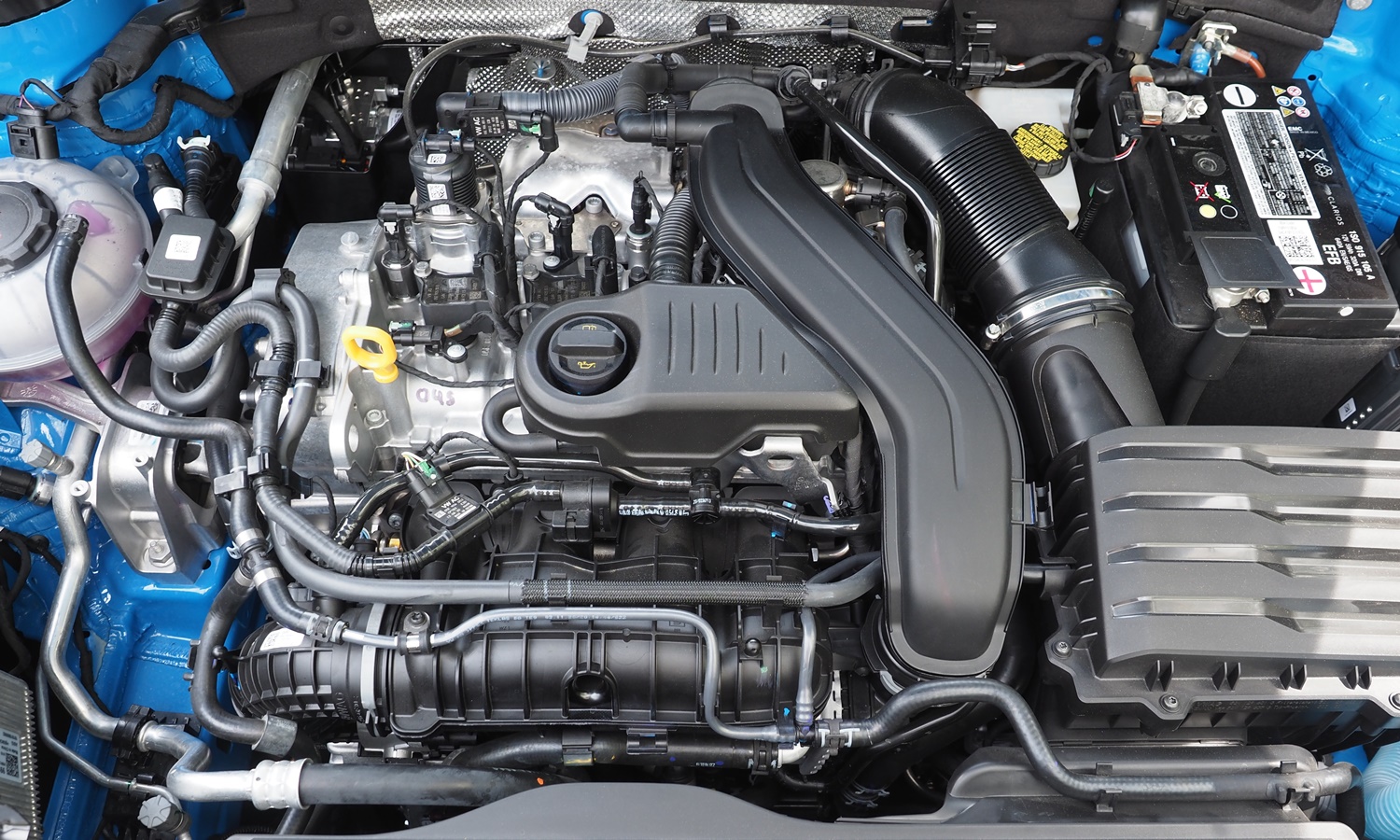
Only this turbocharged 1.5 is offered. Easily adequate but not thrilling performance.
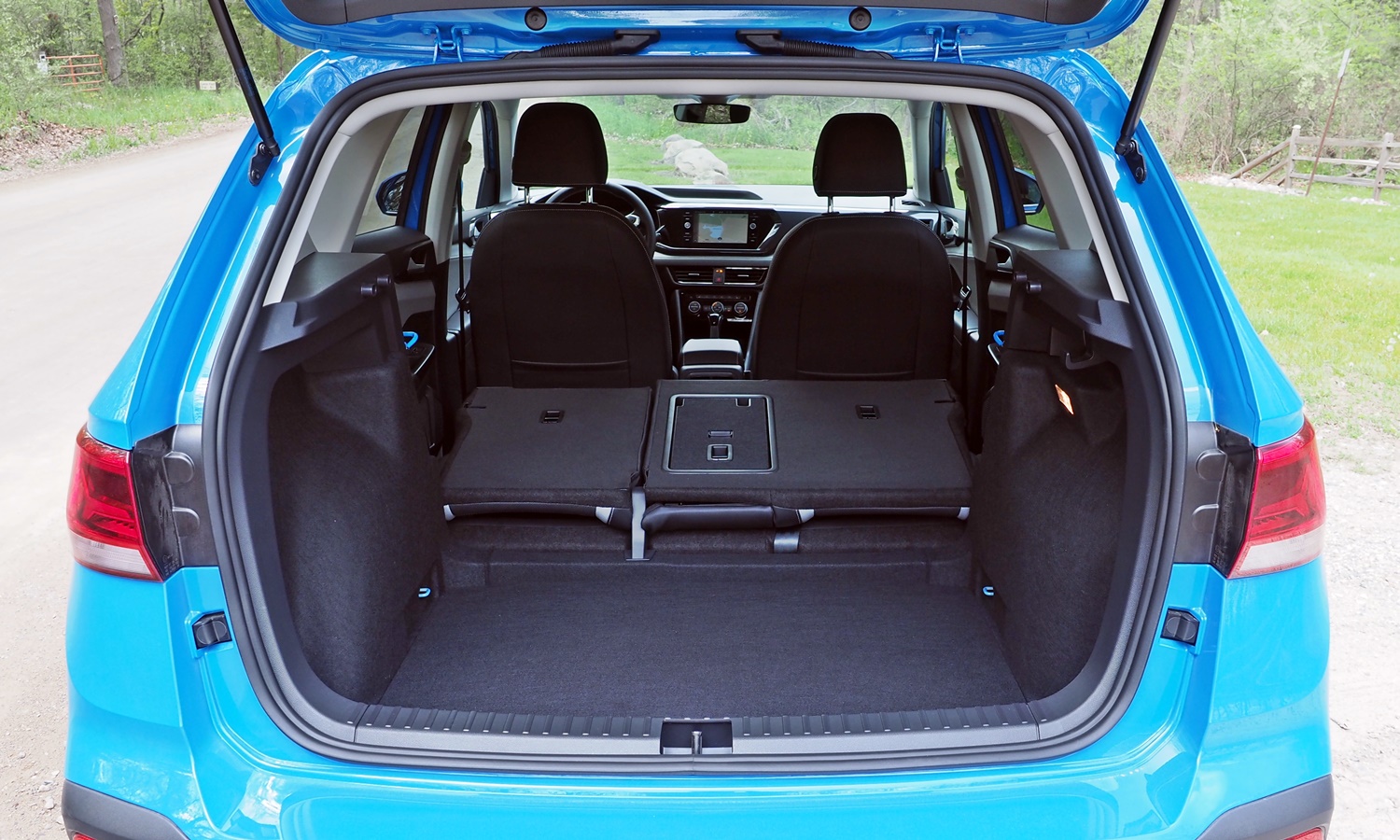
An even larger advantage in cargo volume with the seat folded. But the resulting floor isn't level.
See more 2022 Volkswagen Taos photos
VW provided insured, fueled vehicles and snacks at an event for invited media. Kia provided an insured vehicle with a tank of gas for a week.











